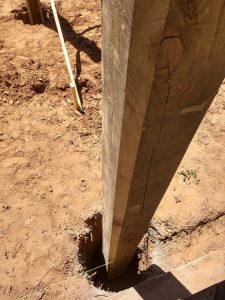In construction of a typical standard stick frame (stud wall), masonry, all steel, or probably just about any other type of building, it is essential for the footings and foundation walls to be level. In layman’s terms – all at the same height.
Pole buildings are much more forgiving than other types of construction, and afford a much greater margin for errors, particularly in the hole digging phase.
To answer the question as posed, the answer is to dig the post holes with a skid loader (aka Bobcat), having a auger attachment. By placing a mark on the auger shaft (a dot from a rattle can of spray paint works well), the holes can all be dug to a similar depth below the natural grade.
 But….unless the natural grade is perfectly level and every hole is dug exactly the same, the bottoms of the post holes are not at the same level.
But….unless the natural grade is perfectly level and every hole is dug exactly the same, the bottoms of the post holes are not at the same level.
The solution, is at hand….other than in cases of extreme frost depth, or high winds, the bottom of the column embedment for Hansen Buildings is shown as being 40 inches below natural grade. Further, the designs place the “low” end of the column eight inches above the bottom of the hole. This allows for up to 16 inches of grade change, across the building site, without having to order longer length columns.
So, if the site does happen to be perfectly level, and the post holes are all perfectly the same depth, what happens to the extra length of the building columns, above the building eave height?
Once the trusses have been properly placed for height, and the roof framed up, the remaining portion of the columns above the roofline are cutoff.
A word of caution – do not burn the cutoff column portions. These scraps contain pressure treatment chemicals and should be properly disposed of in a landfill.






